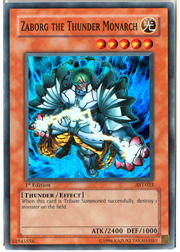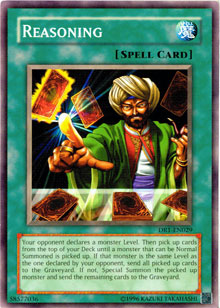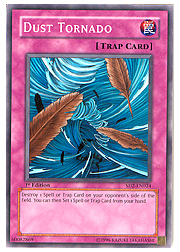There are three types of tribute monsters in this game. The first is the “basic” tribute monster, which are simply monsters that either have average stats or effects without a lot of flash. Cards like Summoned Skull and Battle Steer fit into this category. Obviously, the next two types are more interesting. They are good tribute monsters, but they belong in separate categories, and for good reason. Those that actually generate advantage when splashed into a deck are either “advantage upon summon” monsters or “advantage upon successful battle” monsters.
 “Advantage upon summon” monsters include cards like Zaborg the Thunder Monarch, Mobius the Frost Monarch, and Thestalos the Firestorm Monarch. Other monsters on this list include Jinzo, Blowback Dragon, and Dark Magician of Chaos. These types of tributes are immensely powerful, because they don’t even need to put out a successful attack to generate advantage for you! If you can create a floater on the field (a monster that has already paid for its resource cost), like Sangan, Chaos Sorcerer, or a spent flip effect monster, these monsters essentially provide a free effect.
“Advantage upon summon” monsters include cards like Zaborg the Thunder Monarch, Mobius the Frost Monarch, and Thestalos the Firestorm Monarch. Other monsters on this list include Jinzo, Blowback Dragon, and Dark Magician of Chaos. These types of tributes are immensely powerful, because they don’t even need to put out a successful attack to generate advantage for you! If you can create a floater on the field (a monster that has already paid for its resource cost), like Sangan, Chaos Sorcerer, or a spent flip effect monster, these monsters essentially provide a free effect.
For example, if you flip Magician of Faith and retrieve your Mystical Space Typhoon, you now have a 300 ATK monster on the field and a spell card in your hand. This equation is balanced until Magician is offered as a tribute. If the tribute you summoned was Thestalos, you’ve basically taken a card from your opponent’s hand for free. If you attack and the opponent plays Sakuretsu Armor, the net advantage looks something like this: you lose Magician of Faith and Thestalos the Firestorm Monarch, while your opponent loses Sakuretsu Armor and a card in hand. But in this exchange, you also gain Mystical Space Typhoon. You’ve traded three cards for two, and making such trades consistently over a match will often lead to victory.
As you can see, “advantage upon summon” tributes are incredibly powerful, especially with the proliferation of Soul Control decks. They are generally the weapon of choice for most duelists, but the monsters suffer from one drawback. When you play a special summon card like Premature Burial or Call of the Haunted, a vanilla 2400 ATK monster is simply not as stirring for the soul. The next category of monsters, on the other hand, are as exciting as they come.
“Advantage upon successful battle” monsters are a lot riskier, and for good reason. Cards like Airknight Parshath, Ancient Gear Beast, Dark Ruler Ha Des, and Mefist the Infernal General can easily swing the duel with one successful attack. You usually want to play your special summoning cards on monsters like these (with the exception of Ha Des, which is impossible). And, because the title of this article suggests a deck based on the card Reasoning, you’ll likely want to see Airknight Parshath hit the board far more often than Zaborg the Thunder Monarch.
This discussion of tribute monsters sets the ground rules for a rather interesting deck that I was testing in the last format. It’s an age-old premise that relies on two cards—Monster Gate and Reasoning—to bring out free “advantage upon successful battle” tribute monsters that swing the game. Let’s take a look at the tributes that I’ve selected.
Mechanics of Advantage: The Reasoning Deck
Monsters: 20
3 Airknight Parshath
1 Blowback Dragon
1 Breaker the Magical Warrior
1 Chaos Sorcerer
2 Cyber Dragon
1 D. D. Warrior Lady
1 Dark Magician of Chaos
1 Exiled Force
3 Mystic Tomato
1 Sangan
3 Spirit Reaper
1 Treeborn Frog
1 Twin-Headed Behemoth
Spells: 15
1 Brain Control
2 Enemy Controller
1 Graceful Charity
1 Heavy Storm
1 Monster Gate
1 Mystical Space Typhoon
2 Nobleman of Crossout
1 Pot of Avarice
3 Reasoning
1 Scapegoat
1 Snatch Steal
Traps: 5
1 Call of the Haunted
2 Dust Tornado
1 Mirror Force
1 Torrential Tribute
 The monster lineup packs a few interesting choices. Keep in mind that flip effects are a certified no-no, since a Reasoning or Monster Gate that digs one of those out of the deck will fail and have to go to summer school. (The two effects search for a monster than can be normal summoned, so Chaos Sorcerer will simply get sent to the graveyard.)
The monster lineup packs a few interesting choices. Keep in mind that flip effects are a certified no-no, since a Reasoning or Monster Gate that digs one of those out of the deck will fail and have to go to summer school. (The two effects search for a monster than can be normal summoned, so Chaos Sorcerer will simply get sent to the graveyard.)
You’re looking bring out any of your massive tributes (minus Cyber Dragon), but every other monster in this deck except Breaker is also self-sufficient. You can push through damage or advantage with almost any of these cards, which fits well with the deck’s theme of focused aggression.
Because Blowback Dragon generates advantage upon summon without requiring a tribute, it’s an ideal choice for a Reasoning deck. Dark Magician of Chaos, which generates advantage upon a tribute summon, also has a great effect when battling other monsters.
Brain Control works because you can either tribute from your hand or use that monster for Monster Gate. The three copies of Reasoning are a must, and since the deck cycles through so many monsters, Mike Rosenberg would approve of the one random copy of Pot of Avarice. Scapegoat into Enemy Controller, Brain Control, and Snatch Steal are all viable options for using Monster Gate.
Dust Tornado is your way of pushing. You can set a stable monster and use Dust Tornado at the end phase, then swarm the board with cards like Reasoning. The rest of the traps are self explanatory, and are basically all that’s needed.
The idea here is to generate advantage by putting tribute monsters out onto the field with no tribute cost involved. Imagine if you could normal summon a monster as powerful as Airknight Parshath. It’s possible with this deck! By using the spell or trap zone to clear the opponent’s backfield, the deck can generate hefty advantage through multiple special summons.
Strategies to use in a Matchup with a Cookie-Cutter Deck
(Note that thus far, the new metagame is still being defined. It will take a few Shonen Jump Championships to really set the environment, so any conjecture on my part should be taken with a grain of salt.)
 The new format provides a lot of different viable builds. You can expect variants of Chaos Control using multiple copies of Thunder Dragon, and Flip-Flop control and Dark World remain as powerful as ever, along with Warrior Toolbox and the Monarchs. This deck has a good win percentage against all of them because of its independent advantage generation. The supreme focus and goal of this build is controlled bursts of hyper-aggression, ludicrous overextension (where you may have three powerful monsters on the board at the same time), and overpowering the board when your opponent shows weakness. Typical turn patterns may look something like this: set a monster, then set a spell or trap for a few turns. Then, after your Tomato searches out Sangan, you may use Dust Tornado in the end phase to hit the opponent’s defense. You hold two copies of Reasoning, and the opponent’s board has a face-up monster with a face-down monster. The clear backfield allows you to play both copies of Reasoning, assume heavy field presence, and end the turn with Airknight Parshath, Dark Magician of Chaos, and Twin-Headed Behemoth on the field. Your opponent has just lost 3700 life points, and you have four cards in your hand and five on the field versus his five cards in hand. There’s no Dark Hole to bail your opponent out of that!
The new format provides a lot of different viable builds. You can expect variants of Chaos Control using multiple copies of Thunder Dragon, and Flip-Flop control and Dark World remain as powerful as ever, along with Warrior Toolbox and the Monarchs. This deck has a good win percentage against all of them because of its independent advantage generation. The supreme focus and goal of this build is controlled bursts of hyper-aggression, ludicrous overextension (where you may have three powerful monsters on the board at the same time), and overpowering the board when your opponent shows weakness. Typical turn patterns may look something like this: set a monster, then set a spell or trap for a few turns. Then, after your Tomato searches out Sangan, you may use Dust Tornado in the end phase to hit the opponent’s defense. You hold two copies of Reasoning, and the opponent’s board has a face-up monster with a face-down monster. The clear backfield allows you to play both copies of Reasoning, assume heavy field presence, and end the turn with Airknight Parshath, Dark Magician of Chaos, and Twin-Headed Behemoth on the field. Your opponent has just lost 3700 life points, and you have four cards in your hand and five on the field versus his five cards in hand. There’s no Dark Hole to bail your opponent out of that!
If this type of aggression looks suited to your abilities and is right down your alley, playtest a build of the Reasoning deck!
New Grounds Verdict: Graceful Charity has paved the way for the age of the tribute monster mechanic to shine once again.